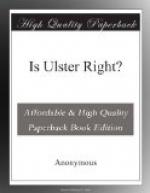When Henry had resolved to do his utmost to bring Ireland to a state of civilization, there were not wanting advisers who urged upon him that his only safe course was absolutely to destroy the whole native population by sword and famine and re-people the vacant lands by immigrants from England. Such a course would have been quite in accordance with the ideas of the time. Not thirty years previously, the combined forces of Church and State had pursued the heretic population of the Loise into the mountain fastnesses to which they had fled, and had piled logs of wood at the mouths of the caves in which they had taken refuge, and set them on fire. Then, when all the unhappy people—men, women and children, numbering some thousands in all—had perished, their lands were distributed amongst strangers brought in from a distance to occupy them. And at a later date—in the middle of the sixteenth century—the native inhabitants of the Canary Islands were exterminated by the Spanish Inquisition, and their lands taken by the invading race. But to Henry it appeared that there was one milder course that might still be possible. Might not the native chiefs and the degenerate Normans who had shown that their only idea of independency was anarchy yet be brought together as nobles under a strong central government with a Parliament representing not merely the Pale, but all Ireland? Might not the mass of the people, whose native customs had been well nigh crushed out by civil wars, be persuaded to adopt the law of England? This was the policy deliberately adopted by Henry and acted on by him during his life. It is easy for writers living in modern times to sneer at some of the details of his scheme; but it is not so easy for them to point out what other course would have been better; or indeed, whether any other course short of a policy of extermination, would have been possible.




